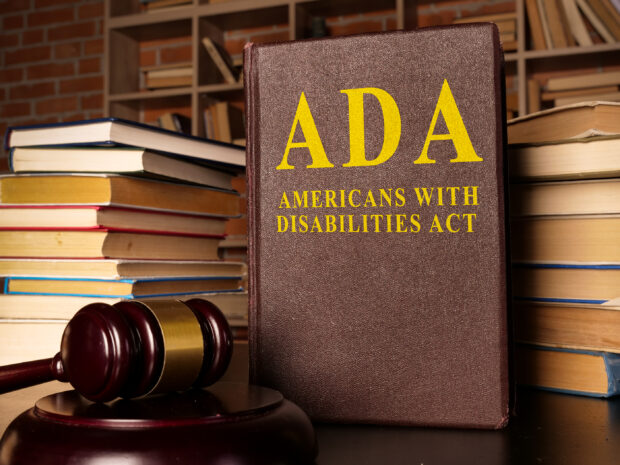Transgender workers will gain broadened legal protections in the wake of a recent federal appeals court decision that gender dysphoria is covered by the Americans with Disabilities Act.
Many transgender people suffer from gender dysphoria, which describes the distress caused by a person’s gender identity not matching that person’s sex assigned at birth. About three-quarters of transgender people who participated in a 2020 Cedars-Sinai study experienced gender dysphoria by age seven.
Transgender workers gained protections against job discrimination with the U.S. Supreme Court’s landmark 2020 ruling that said LGBT employees are covered by Title VII of the 1964 Civil Rights Act.
But the ADA goes beyond just prohibiting bias to requiring that employers provide reasonable accommodations. For workers with gender dysphoria, that could mean getting leave for medical procedures or hormone therapy, as well as modifications to bathroom or dress-code policies, legal observers said.
“If somebody notifies their employer of the fact that they’re transitioning, then there’s a method in place to ensure they can continue to do their job with appropriate accommodations,” said Jennifer Levi, director of GLBTQ Legal Advocates & Defenders’ Transgender Rights Project.
Levi’s group, along with a slew of other civil rights organizations, filed a brief in the U.S. Court of Appeals for the Fourth Circuit supporting former inmate Kesha Williams’ bid to revive her ADA lawsuit against a Virginia sheriff.
The Fourth Circuit this week sided with Williams and declared that gender dysphoria is a disability under the ADA. The law’s exception for gender identity disorder—a now discredited diagnosis that pathologized being transgender—doesn’t apply to gender dysphoria, the court held.
Williams sued under Title II of the ADA, which applies to disability discrimination in the provision of government services. People with disabilities that are recognized by the ADA get the full protection of the law, which also covers employment and access to public facilities.
Williams also alleged violations of the Rehabilitation Act, which prohibits disability bias in the federal sector and uses the ADA’s definition of disability.
‘Heed This Trend’
The decision on gender dysphoria “will provide critical protections for trans and nonbinary people in the workplace and elsewhere,” Jocelyn Samuels, a Democratic member of the Equal Employment Opportunity Commission, said in a tweet.
The ruling is binding law within the Fourth Circuit, which covers North Carolina, Virginia, Maryland, South Carolina and West Virginia. It also follows a trend—the Fourth Circuit cited five district court rulings from other circuits that reached the same conclusion.
“Employers are wise to heed this trend, recognizing that the best practice is to engage in a robust interactive process with employees to determine whether reasonable accommodations are appropriate in these situations to help the employee perform their job,” said Jeff Nowak, a management-side attorney at Littler Mendelson PC.
The federal bench, however, hasn’t been unanimous on gender dysphoria and the ADA. The Fourth Circuit ruling was divided, with Trump-appointed Judge A. Marvin Quattlebaum Jr. dissenting.
There’s also disagreement at the trial court level. U.S. District Judge C. Lynwood Smith Jr., a Clinton appointee, ruled in 2019 that the ADA excludes gender dysphoria.
“Eventually, we might see a circuit split develop,” said Nicole Buonocore Porter, director of Chicago-Kent College of Law’s Institute for Law and the Workplace.
Evidence of Animus
The debate over whether gender dysphoria is covered under the ADA centers on the law’s section excluding gender identity disorder, along with “transvestism, transsexualism, pedophilia, exhibitionism, voyeurism” and “other sexual behavior disorders.”
The Fourth Circuit distinguished between gender identity disorder, which the American Psychiatric Association removed from the Diagnostic and Statistical Manual of Mental Disorders, and gender dysphoria, which wasn’t acknowledged by the medical community when the ADA was passed and was added to the fifth edition of the DSM in place of gender identity disorder.
“Put simply, while the older DSM pathologized the very existence of transgender people, the recent DSM-5’s diagnosis of gender dysphoria takes as a given that being transgender is not a disability and affirms that a transgender person’s medical needs are just as deserving of treatment and protection as anyone else’s,” Judge Diana Gribbon Motz, a Clinton appointee, wrote for the court.
The Fourth Circuit said if there was any doubt about whether the ADA excludes gender dysphoria, the court would rule that it doesn’t in order to avoid the “serious constitutional question” of whether the law’s exception violates the Equal Protection Clause of the 14th Amendment.
There’s clear evidence of anti-transgender animus in the exception itself, which likens being transgender to being a pedophile, and in the legislative history, which includes senators making harsh moral judgments against transgender people, the court said.
The open anti-transgender bigotry in the ADA exception’s legislative history is clearer than whether gender identity disorder encompasses gender dysphoria, said Ruth Colker, a professor of constitutional law and disability discrimination at Ohio State University.
The Fourth Circuit’s ruling invites plaintiffs to win on ADA coverage of gender dysphoria via the canon of constitutional avoidance, by raising the constitutional issue and highlighting the ambiguous language the DSM-5 uses for gender dysphoria, Colker said. The harsh transphobic comments in the legislative history make that strategy viable, she said.
“Usually, you don’t have a smoking gun for animus,” Colker said. “But here the legislative record is crystal clear.”





















 U.S. E&S Outlook No Longer Positive: AM Best
U.S. E&S Outlook No Longer Positive: AM Best  Getting the Embedded Ecosystem Right
Getting the Embedded Ecosystem Right  The Power of the First Offer: Anchoring, Evidence and the Battle for Perception
The Power of the First Offer: Anchoring, Evidence and the Battle for Perception  Artificial Intelligence on Trial: What Recent Lawsuits Reveal About Casualty Exposure
Artificial Intelligence on Trial: What Recent Lawsuits Reveal About Casualty Exposure 